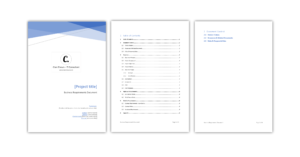
Will new software improve manual processes?
This article will explore if software will always improve manual processes.
Most people assume that by replacing manual processes with technology their day-to-day work lives will become better. This is not true, if the solution is not thought through properly. Software will be a hindrance rather than a solution. In complicated business processes, we need to be sure that the software will make life better, ideally we should be able to measure this with business intelligence data. What can often happen is by removing a manual process and replacing it with software, we remove one problem but create new ones. Badly implemented software can sometimes be like the mythological Greek monster Hydra, chop off its head and two new ones will regrow.
My real world example
In one project I worked on, the executive team wanted to remove a paper form, telephone staff were using to record customer’s answers and replace it with an electronic form. This makes sense in our technological and data drive world. But little did the executive team know, that that paper form was also used as a task management tool. A replacement for a task management tool was not scoped for the project. And would increase the release date and increase training needs. There was no budget or technical resources available to build a task management system. Mapping the business process in this instance helped identify the potential problem, and the team reconsidered how to approach the original problem.
In this example, replacing a manual process was going to create more problems. That doesn’t mean the manual process should stay, it does mean an alternate solution should be sought.
Why remove manual processes?
The point of replacing manual processing with software is generally to:
- Reduce errors
- Increase customer satisfaction (reduced price, more efficiency, less wait time)
- Free-up staff to focus on more difficult cases/tasks
- Reduce labour and resource costs
- Be able to make data driven business decisions
- Enable new functions, features and business processes
Issues that can be faced:
- Forcing old customers out of the sales pipeline without realising it.
- Trade-off of features and functions.
User push back
Users are usually so proficient with manual processes, that taking up new software will seem inefficient, to them at least. We have to ask the question, is it really the software at fault or is it a lack of user experience/training. This can touch on the issue of change management, are staff on board with the change or is there resistance?
In an environment with heavy manual processing, you generally have none technical staff. Switching their work from manual to software orientated, can cause anxiety. Anxiety over losing their jobs, becoming instantly less skilled, fear that they will not be able to learn the new process. And also legitimate fears that customers will suffer because the technology wont serve them in the same way as before. This is all part of dealing with digital transformation and a great challenge for the Change Management team.
We also have to be mindful that generally removing manual processes from staff is management driven. Staff might not actually want the change and the benefits might only be seen from above. Staff will always be worked to full capacity, the automation and introduction of software should just make their work more efficient and mean they help the highest priority customers.
How to remedy software culture shock
- Be tough on the change staying around for a long time. Its an evolution, every company has to evolve to stay up-to-date, if you waiver you will lose faith that you know what you’re doing.
- Consultant and involve key users, subject matter experts, influential and well likes staff members from the beginning.
- Do UX testing and even consider UX driven development with customers and staff from the beginning.
- Share information and concerns, don’t keep things hidden from your staff or even your customers.
- Apply empathy.
Understand your goals
I have two examples of projects I’ve worked on where software was replacing highly manual processes. Both organisations found it hard to come up with good metrics to measure success. To start with metrics of success you need to understand the reason for the change. Project One’s reason was to make staff more efficient and streamline the business process. Project Two’s reason was to move away from paper and digitalise its services and make them more accessible and quicker. With either project and all manual to digital processes, we have to ensure gains on application and application processing times. Meaning, for both customer and staff the process has to become easier and more efficient. How can we measure this?
Making them work for it – Staff vs Customer
When rebuilding your manual processes and switching software, you will need to make decisions on whether you move a piece of work to the customer or the staff member. Of course, where possible you make the system do the work. In some cases this will not be possible. So how do you know whether to shift the work onto the customer or the staff member. Somethings to consider:
a. Do you legally require the customer to make choices? Does the customer legally need to enter data in and/or make choices in their application, or can this be done by the staff member? For example opt-in or opt-out. When a customer has to provide documented evidence anyway, do you still make them enter the same data in the application?
b. Create a model of your optimal processing time, from beginning to end. This should help guide your decision making on where to shift the work from customer to staff member. Remember you can’t put all the onus of work on the staff member in order to make the initial customer experience easy. Because you will end up creating a bottleneck of work and overloading staff, unless you have a large work force, but this will cost more.
c. If the piece of work is small and simple, perhaps its best to get the customer to perform it. Remember we want our expensive well trained staff to be handling the rare, complex and high profit customer cases. We don’t want them to be handling small, simple and repetitive tasks. Distribute the small things to ‘the many’ – that is to say the customers. Entering a small piece of information for the customer once, is not as big a deal, as one staff member entering the same piece of information 100’s of times a day.
To summarise
Don’t always make the assumption that by replacing a manual process with software, that everything will work out. The key is knowing your business process. Can you tell me how the future state will differ from the current state? If not, you should, before you design or code anything.
- Understanding business goal
If you don’t know where you’re headed, how will you know when you’re there? - Identify risks and changes in business process
Don’t solve one problem and create another one for someone else. - Handle the people side of change management
Don’t keep your stakeholders in the dark, mitigate software culture shock before it sets in.

